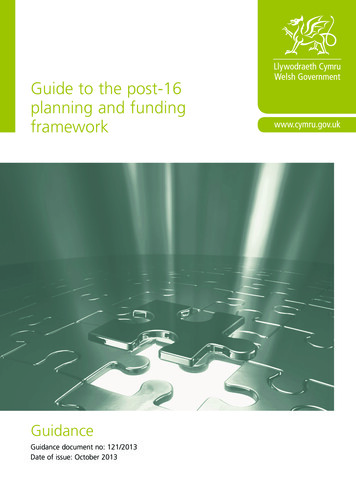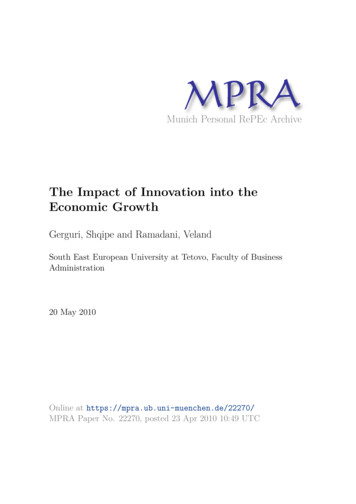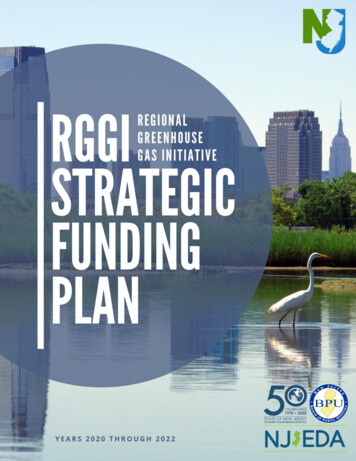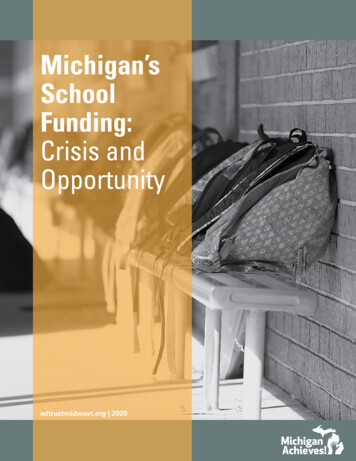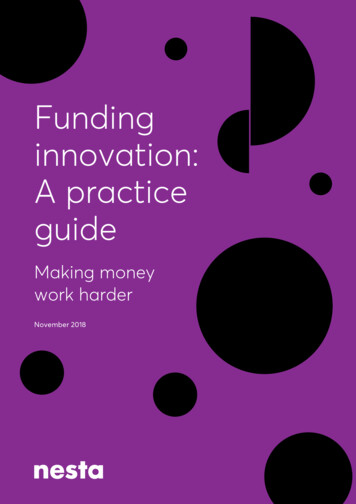
Transcription
Fundinginnovation:A practiceguideMaking moneywork harderNovember 2018
AcknowledgementsThis guide was created by Vicki Sellick, Amy Solder (Innovation Programmes team)and Isobel Roberts (Innovation Skills team), with support from Rosalinda Baker (CEOteam). It draws on the work of many of our Nesta colleagues and a range of other Nestapublications, including:Investing in Innovative Social Ventures: A practice guide by Katie Hill and Joe Ludlow.Challenge Prizes: A practice guide by Perrie Ballantyne and the Centre for Challenge PrizesMatching the crowd - Combining crowdfunding and institutional funding to get great ideas off theground by Sam Mitchell, Jonathan Bone and Peter BaeckThanks to additional contributions from Olivier Usher, Shannon Harmon, Peter Baeck, BenGill, Isabel Newman, Alex Hook, Brenton Caffin, Geoff Mulgan, Alice Casey, Rob Ashelford,Carrie Deacon, Ishaan Chilkoti, Lucy Heady, Seva Phillips, Angharad Dalton, Halima Khan,Katy Rutherford, Rachael Bull, Nathan Elstub, John Loder and Helen Durham.Nesta’s Practice GuidesThis guide is part of a series of Practice Guides developed by Nesta’s Innovation Skillsteam. The guides have been designed to help you to learn about innovation methods andapproaches and put them into practice in your work.For further information, contact skills@nesta.org.ukAbout NestaNesta is a global innovation foundation. We back new ideas to tackle the big challenges ofour time.We use our knowledge, networks, funding and skills - working in partnership with others,including governments, businesses and charities. We are a UK charity but work all over theworld, supported by a financial endowment.To find out more visit www.nesta.org.ukIf you’d like this publication in an alternative format such as Braille, large print or audio,please contact us at: information@nesta.org.uk
Funding innovation:A practice guideMaking money work harderNovember 2018Introduction4Section ALandscape of funding tools5Section BHow we use different funding tools12Grants112a. Stage-gate grantsb. Match funding dependent grantsc. Revenue dependent grantsd. Convertible grants17192021e. Combination grants222 Challenge prizes233 Matched crowdfunding274 Impact investment31a. Loansb. Equityc. Social impact bonds3336395 Other funding tools40Section CDesigning funds41Section DSummary46Section ECase studies47
Funding innovation: A practice guide. Making money work harderIntroductionNesta is an innovation foundation, with a role to stimulate innovation for the common good.Over the years we have experimented with many different ways of using money to achieveresults - such as crowdfunding, equity, loans and social impact bonds (collectively calledimpact investment), challenge prizes, grants and intermediary funding, as we’ve backedthousands of innovators in public services, charities and social business.In this guide, we summarise some of what we’ve learned about how to use moneyeffectively. We set out the many options available to funders – who often tend to use justone or two methods and so miss out on others that might be more appropriate.How to use this guideThis guide is primarily aimed at funders – governments, agencies, investment organisationsand foundations who provide funding for projects or organisations to support innovation.We hope this guide gives them an insight into different financial tools that can be usedto support innovations – what they are, how they can be used and what some of thechallenges are around using them.As part of Nesta’s Accelerating Ideas Fund, the British Lung Foundation received a grant to expand their peer supportprogramme (see page 13)4
Funding innovation: A practice guide. Making money work harderSection ALandscape of funding toolsMany organisations fund innovation. In some fields, such as science, academic research ortechnology, the financial tools used to support innovation are well-understood and mature.In this guide, our focus is on organisations funding innovation for public benefit in fields likeeducation and health, housing and jobs where the systems for supporting innovation tend tobe a lot less developed. These organisations may use funding to: Achieve a result, output or outcome that is clearly defined in advance, such as betterschool results or less homelessness. Create capacities for achieving outcomes in the future, including better capacities toinnovate. Test or explore ideas, where the key goal is new knowledge.There are then many ways of using money to achieve these goals. In Table 1 on the followingpage, we show some of the financial tools that can be used. These include grants, loans andequity, challenge prizes and social impact bonds, matched crowdfunding to procurement,and often they can be used in combination.The Central School of Ballet received loan finance from the Arts Impact Fund (see page 55) to help open itsnew premises on London’s South Bank, increasing its capacity and ability to work with local communities.5
Funding innovation: A practice guide. Making money work harderTable 1: Landscape of funding toolsFunding toolDescriptionAdvantagesChallengesGrantsGift of money, usuallylinked to commitmentson activities, outputs oroutcomes.Simple, established.How intensively to manage, can drivedependency. No return to funder.Grants forR&D fundingStage-gate funding withpayments released asproduct developed/evidencedemonstrated.Suitable for high risk/rewardprojects.Requires greater management.Grants/equity inaccelerators instage-gateGrants plus small equityshares for new companies,often linked to non-financialhelp.Higher success rate forstartups.Intensive input needed to achievesuccess.Grantsconvertible toloans, or grantswith royaltiesGrants with conditions thatmake them turn into loansonce milestones are met,e.g. on revenues.Recycles money, drives goodbehaviours re: financialsustainability.Requires longer-term engagement tocheck on revenues and repaymentschedule. Modelling of repaymentwill often be overly optimistic. Can begamed if repayment triggers are notset right. Tax/accounting treatmentnot well established.Grantsconvertible toequitySimilarly, grants which turninto rights to equity oncerevenue or other milestonesare met.Recycles money, share ofhigh value projects.Managing investment, follow-onfunding, getting the conversiontriggers right. Only feasible ifrecipients established with shares.Tax/accounting treatment and legalenforceability not well established.MatchcrowdfundingCommitting money oncondition that matchedfunding is raised throughcrowdfunding platforms.Encourages mobilisationof public money andcommitment. Engages wideraudience of backers.Skews to high income audiences;sums still quite small.LoansMoney lent to be repaidwith interest over agreedtimescale.Recycles money.Straightforward offer torecipients. Easy to value costand likely return.Managing loan book, risk assessmentand security.Project-specificloansLoans linked to specificprojects, e.g. in technology,repaid only if the projectssucceed.Recycles money.Straightforward offer,attractive to recipient as norepayment if project fails.Less secure than loans secured againstthe firm as a whole (see above).ConvertibleloansLoans offering rights toconvert into equity.Gives lender chance toparticipate in upside in caseof radical success, whilestill promising repayment inbase case.Can put off future equity investors ascarried on recipient’s balance sheet.Funder needs to manage conversionprocess.Quasi-equityLoans offering revenueparticipation rights (e.g.shares of revenue or profitover given levels).Encourages business growth,recycles more money fromsuccesses.General challenges of oversight andmonitoring.6Staging can limit project flexibility.Need to monitor project success to seeif loan needs to be repaid (this can begamed).
Funding innovation: A practice guide. Making money work harderImpactBonds (social,development,etc.)Funding raised fromphilanthropy or capitalmarkets with commitmentof payments linked tooutcomes.Shifts risk from government;encourages focus onevidence and outcomes; canbring in new skills.Relatively few fields with suitableconditions; still young model inexperimental phase.Venture equityinvestment (andimpact ventureinvestment)Investment in equity inearly-stage companies,usually with aim ofsignificant growth invalue and linked toactive involvement inmanagement, strategy, etc.Impact investment alsoaims for social impact.Funder can participatein upside. Funder gains(some) control in firm.Allows rigorous linking ofinvestment and outcomes(e.g. using standards ofevidence).Intensive management needed forrealising value and securing followon funding. If funder is charity, link toobjects and public benefit must bemonitored. Difficult to exit. Averageventure capital returns very low.IntermediaryfundingFunding directed throughintermediaries (e.g. on BigSociety Capital model) whichthen invest loans, equity, etc.,in firms or social enterprises.Usually investors representedon investment committee.Can increase funding flows(e.g. with co-mingled funds);creates more specialistcapacity and some healthycompetition. When workingwell, interest from loanscovers management costs.Sometimes challenges raisingmatched funds; achieving sufficientscale; and handling timescales ofinvestments and returns.ChallengeprizesCommitments of fundingtied to proof of ability tosolve a novel problem.Good for where marketincumbents have littleincentive to innovate. Raisesawareness and attractsnew entrants. Favourstechnological/productbased innovation.Challenge of setting the right goal:requires expertise and is difficult tochange once set. Success needs to bewell-defined. Requires firms to spendmoney ahead of government funding.Revenue-basedfunding modelsReleasing grants or loans inresponse to reaching revenuetargets.Aims to encourage tradingand entrepreneurship, asopposed to grant dependence.Used in development,technology, self-employmentand other fields.Revenue results achieved can havemany causes, therefore may providecapital where it’s not needed;conversely can push recipients tomaximise short-term revenue ratherthan long-term business building.Golden shareEquity finance linked to aspecial share which cannotbe diluted, or offers specialvoting rights.Opportunity to participatein upside without follow-oninvestment. Gives fundercontrol over firm.Represents a significant concessionfor organisation receiving funding.May deter future equity investors.Services contractto supportinnovationsProcurement of servicesfrom small firms, charitiesor social enterprises as away of helping them grow orinnovate (e.g. SBIR).Uses procurement processto support small innovativeentities.Reliance on relatively untried serviceprovider.Most funders just use one or two tools and never seriously consider using other ones whichcould make their money go further. These tools range across a continuum from pure grantsdesigned to achieve public benefit, to very commercial investments primarily designed toachieve a private return. Our hope is that this guide goes further in helping to encouragemore creative thinking about how to use funds to achieve objectives, as well as greaterawareness of how to fit the right funding tool to the right goals.7
Funding innovation: A practice guide. Making money work harderTaking a portfolio approachRather than focusing on only one or two approaches, using a mix of funding mechanismsallows funders to explore different rates of returns on their investments and supportinnovations at different stages in their journey. Figure 1 below uses examples to illustrate theportfolio of Nesta’s activities to support innovation.Figure 1: Nesta’s portfolio of financial commitments to innovationReturnmaximisationNesta Venture Capital PortfolioNesta ImpactInvestmentsInvestment inbacking acceleratorsNesta’sinvestments inother impactinvestment fundse.g. Big Issue InvestArts Impact FundInnovate to SaveRethinking ParksMatchedCrowdfundingCentre for Social ActionInnovation FundChallenge prizesNo gIdeasLimitedcustomersManycustomersNational/global reachOomph! provides exercise training and runs excursions services for care homes, and is one of the social businesses supportedby Nesta Impact Investments (see page 58)8
Funding innovation: A practice guide. Making money work harderDesigning innovation funds in governmentThere are now thousands of innovation funds in operation in governments around the world.Some focus on a particular kind of organisation (e.g. schools); some aim to improve innovationin systems (such as the health service); some aim to promote an idea (e.g. promotingvolunteering or use of technology). Some are internal, backing ideas within the public sector,while others face outwards.Nesta has a lot of experience running, advising,researching and designing funds. These funds canbe designed in many different ways depending on: The goal. The primary goal of the fund may beto generate new ideas; to take them to scale;to achieve cashable savings; or just to shiftcultures. These lead to many options for design. Ways of using money. As this guide showsthere are many ways to use money – includinggrants, loans, equity and combinations. Butmost governments automatically use the onethey’re most used to. How the stages through which ideas developare managed. Some funds have stage-gates,starting out by funding many ideas at smallscale and then backing fewer at larger scale. Butoften the temptation is to get money out quickly. How evidence and impact are organised. Weall want to know that spending is achievingresults. But early-stage innovations needfreedom to take risks and explore: too manyonerous or rigid measurement requirementscan kill creativity (though it’s important togather data and learn). By contrast, later-stageinnovations benefit from much more rigorousassessment. In between, experiments usingcontrol groups can help to clarify what impactis being achieved. How internal, how external? Funds tend tospecify likely recipients. They can be mainlyfor existing public servants, or aimed at startups and other external organisations. This willgenerally reflect the goal – if the goal is toachieve an outcome, then there should be asfew restrictions on who can benefit as possible;if the goal is to shift cultures, it may make moresense to restrict funding to projects within thepublic sector.MistakesIn our experience, two common mistakes are madein the design of many, if not most, innovationfunds, particularly ones run by governments.The first is insufficient focus upstream. Too littleattention is paid to preparing the ground, sharingideas and evidence and helping the people whoare developing ideas at an early stage to developbetter ones. This failure to curate, encourage andeducate generally means that applications arelower quality, less inspired and less aware of whatothers have tried. Nearly always, more upstreamwork pays off, even though this might be seen asan unnecessary cost.The second error is insufficient attentiondownstream – failing to ensure a line of sightfrom an idea to scale. That may mean a route totaking an idea into policy or programmes if it turnsout to work, or it may mean a route to gettingan innovator a contract and mobilising publicprocurement. Without a clear line of sight to scale,funds risk supporting a range of interesting pilotswith nowhere to go.These two errors often come together. Ministersoften quite like innovation funds. But too manyfunds are put together quickly, with little attentionto what has been learned previously, too muchfocus on getting money out of the door quickly toas many recipients as possible, too low a qualitythreshold (so that most aren’t very innovative)and without a route to impact. These errors arerepeated, again and again. As a result, a lot ofpublic money which could be playing a criticalrole in helping public systems to evolve and adapt,instead goes to waste.9
Funding innovation: A practice guide. Making money work harderImproving both supply and demandThe primary focus of this guide is on funding innovation, rather than just funding goodworks, or just achieving a good financial return. The ultimate aim for most innovations isto scale their impact, in order achieve maximum benefit, for as many people as possible.To do so, innovations need to have an alignment of supply and demand, and this is a keychallenge for funders and one that is frequently overlooked.It’s usually clear how you might use funding to improve the quality of supply: funding anearly idea to refine it, gather more evidence about impact or improve it technically. Butunless there is demand for the idea, even the most perfect innovations will fail to spread.With social and public innovation, that demand is often indirect, since the purchasers areoften not the same people as the direct beneficiaries. That’s true of most education andhealthcare, as well as social services. So providers of innovations have to persuade the keydecision-makers to shift resources from what they’re currently purchasing to something new.That may involve advocacy – e.g. persuading governments that a problem matters – as wellas showing hard evidence that an intervention works.Additionally, research may also be required to understand what the real demand actually is.Often, the issue that needs to be addressed may be invisible or unexpressed in the currentway of doing things. Approaches such as ethnography and service design can help tounpick this and identify the right issue to tackle through funding.Where effective supply and demand are combined, innovations can simultaneouslyachieve social impact and prove to be financially sustainable. The key point is that fundingsometimes needs to be directed to creating the environment for the innovation to thrive aswell as to the innovation itself. Figure 2 below demonstrates the space in which innovationsevolve and grow.Figure 2: The growth mapHIGHABCDEffectivedemand forinnovation(’pull’)LOW10Effective supply of innovation (’push’)HIGH
Funding innovation: A practice guide. Making money work harderSupply does not automatically elicit demand, or vice versa, but supply and demand doinfluence each other – for example, when a successful demonstration project persuadesthe public to look in a new way at the need for action to address a social problem, or whenpublic concern persuades existing innovators to redirect their energies. For innovations toachieve maximum social impact, they need to be in the top right-hand quadrant (B) whereviable innovations find customers who are willing to pay.Prototypes for rapid diagnostics in preventing the unnecessary use of antibiotics, developed as part of the Longitude Prizerun by Nesta’s Challenge Prize Centre (see page 53)11
Funding innovation: A practice guide. Making money work harderSection BHow we use differentfunding tools1 GrantsGrants are non-repayable funds, a gift of money usually linked to commitments onactivities, outputs or outcomes. Grants are a simple and established form of funding widelyused by charities, foundations, trusts, corporate giving and some government funding.However, funders are often limited in their use of grants, opting for the simplest form – agift of money with no return to the funder. A criticism of grant funding is that it risks drivingdependency rather than supporting sustainable initiatives.What is less well known are the many variations and adaptations of grants thatorganisations could be using, as well as the different types of organisations that could befunded to help reach a desired public benefit goal – including social businesses.Nesta’s experience with grant makingNesta has extensive experience of using grant funding to support social innovation. Since2012, we have awarded 54 million in grants. The majority of our grants are awardedthrough ‘innovation grant funds’, which are designed around a theme or area of activitywhich has long term potential (see page 14-15).The fact that Nesta is grant funding innovation, rather than immediate delivery ofoutcomes, leads us to a very different approach to funding that we have been developingand refining over many years. We operate as a ‘high support, high challenge’ funder tohelp maximise innovations’ scale and impact. Our approach is more aligned to that usedby early-stage impact investors than that adopted by more traditional grant funders. Inpractice, that means we work intensively with our grantees throughout the lifetime of a fund– with regular check-in meetings where evidence and progress are discussed, and ongoingmentoring and capacity building support that is often bespoke to an innovation’s needs.More often than not, our relationship with grantees starts before grants are agreedand signed. Like most funders we proactively promote funds via live events, webinars,syndication through regional partners and their networks, blogging and wider commsactivity. But we go further, encouraging innovations to speak with us before they submittheir ideas, supporting shortlisted innovations develop the quality of their proposals andoffering support in working out how to operate as a partnership. If successful, our grantagreements are then co-designed with the grantees - an important part of the process ofagreeing what will be achieved and how.12
Funding innovation: A practice guide. Making money work harderOur approach to grant funding innovation focuses as much on capacity building as it doeson financial support. We work intensively with our grantees throughout the lifetime of afund, therefore funding needs to be: Tolerant of risk and failure, with support in place to anticipate and mitigate againstfailure where possible – and an appetite to reflect and learn from failure and use it as aspur to creating better solutions in the future. Flexible to changing circumstances and evolving understanding – with regular checkins to discuss and assess progress and an emphasis on building a relationship of trustwhere problems and challenges can be shared and resolved. Focus on long-term financial sustainability and scaling as much as on immediatebeneficiary impact, which leads us to think as much about the development of theorganisational leadership and delivery capacity as the project delivery. Essentially, wewant innovations to be as financially sustainable as possible (from whatever fundingsource is most appropriate e.g. commissioner contract, user payment, etc.) so that theyavoid a ‘cliff edge’ at the end of a grant.Over the years, we have experimented and refined how we design and run innovation grant funds,choosing different approaches dependent on what we want to achieve and a sector’s need today and inthe near future. It’s worth noting that we generally work in partnership to deliver our grant funds, whichenables us to get buy-in from key sectors or influencers, share learning more widely, increase funding forinnovations and amplify our impact. Outlined below, is a variety of grant funds we have designed overrecent years:Prototyping and testing new ideas (earlypioneers) – for example Innovation in Giving,a partnership with the UK Cabinet Office,which sought the best and most radical newideas for increasing the level of giving (timeand money) and sharing. Fifty-six innovationswere awarded up to 50,000 each andcapacity building support to prototype theirideas, with a subsequent stage-gate to awardadditional funding if successful. We useprototyping funds to support innovators totake a more structured approach to testingand improving an idea at an early stage,before committing more resources to it.Scaling promising innovations - such asAccelerating Ideas, a partnership with BigLottery Fund, which is supporting eightpromising ageing innovations to increasetheir reach and impact to many more peopleacross the UK. The fund awarded 5.48 millionin grants over five years - as we know toscale successfully takes time and patience.Scaling funds are designed to support socialinnovations to reach more people, achievinggreater impact. For example, through the 14million Centre for Social Action: InnovationFund we supported a range 42 innovations toscale. From relatively early-stage innovationsthat have worked in a small number oflocalities and have some evidence of impact(e.g. Code Club to grow from 1,108 to 5,000clubs) through to more developed solutionswith a stronger evidence base and operatingat some scale (e.g. Shared Live Plus).Stimulating a sector to innovate – includingCreative Councils, a partnership with LocalGovernment Association, which sought tostimulate innovation in local government bygetting them to think about opportunities andchallenges, generate ideas and make the casefor change. We selected 17 councils with themost promising ideas and worked with themover a period of nine months with small grantfunding and capacity building support. Fivecouncils then received an additional 150,000grant funding and bespoke capacity buildingsupport to further develop their innovations.Replicating successful models – forexample Cities of Service, a partnership withBloomberg Philanthropies and the UK CabinetOffice, which offered groups in UK cities toreplicate a US model of mobilising largenumbers of volunteers to address key localchallenges in seven UK cities.13
Funding innovation: A practice guide. Making money work harderSetting up and running a grant fundNesta’s approach to setting up and running a grant fund can be seen as being made from thefollowing building blocks:StructureDiscoveryFind andselectSupport andchallengeCommitmentto learningSustainConnect and amplifyDiscoveryWhen grant funding innovation, the first task is oftento find a theme or area of activity which has long-termpotential. Within a theme, we aim to focus on whatinnovators need today and in the near future. The stagewhich innovations are at is critical – early pioneers,scaling, and integration with mainstream practice allrequire different approaches.Similarly the model of change matters. Complex in-system change, digital startup innovation, translationalresearch, incremental improvement, and campaigns toshift attitudes and norms are all valid forms of innovation.To design an innovation grant fund you will need toundertake a discovery phase to understand the sector inwhich the fund will operate - its stakeholders, stage ofdevelopment, institutional forms, evidentiary standards,networks, development needs and paths to scale, etc.StructureDepending on the focus previously identified, the fundcan require different: Eligibility criteria – certain types of organisation orpartnerships are likely to be targeted. Grant size – a small startup can use 25-50keffectively. Within a large organisation however,smaller projects can lose visibility and traction. Beneficiary outcomes – these can vary widely. Weput a premium on measurable outcomes that canevidence and support the growth of the field.14 Timescales – digital innovation can be prototypedrelatively quickly; change in large public sectororganisations can take much longer to becomesustainable. Support – needs vary for different grants andmight include support on evidence, governance,connections, marketing advice, etc. Without thissupport, cash is used less effectively than it would beotherwise.
Funding innovation: A practice guide. Making money work harderFind and selectThe single most important factor in the success of agrant fund is probably the quality of the applicants –securing these is not straightforward, especially whenwe seek to reach beyond the ‘usual suspects’. We areproactive in seeking out the best applications and runlive events, webinars and, for shortlisted candidates,time with a dedicated Nesta staff member. Oncewe have received applications we often use expertsto help us assess, look at whole portfolio of risk,understand the supply and demand side of innovationand carry out careful due diligence.Support and challengeWe practice a more intensive form of grantmanagement than most funders – we refer to thisas ‘high support, high challenge’, more aligned to anearly-stage impact investor. We stretch and challengeour innovations but also give them valuable, oftenbespoke, advice and capacity building supportthrough the lifetime of a fund. This could includesupport with marketing and communications, businessplanning, financing and fundraising, governance andevidence creation.Commitment to learningEvidence and learning is integrated throughout ourinnovation grant funds. We expect innovations tohave a Theory of Change which explains what theydo (or want to do) will logically have an impact on theultimate outcome. On scaling funds we will invest inindependent evaluations to demonstrate correlationor causality (see Nesta’s Standards of Evidence page44) and all innovations need to commit to learningfrom their work and sharing this with others.Connect and amplifyThe impact of our funding is massively reduced iffew people hear about its successes, so we supportgrantees to build their profile to become sustainableand grow. We connect them to senior decisionmakers and invest in high quality evaluations. Wealso understand, that much of the impact of fundinginnovation come from replication and adoption byothers. Therefore, we invest in translating the impactand learning of funds into striking and accessibleoutputs - events, practice guides, evaluations,compelling narratives and stories.SustainThis refers to the period after the grant has ended.If the innovation ends with the fund, then thegrant relationship did not succeed, no matter howsuccessful it was during the period of funding. Whilea degree of failure goes with the territory, and showsthat we are taking sufficient risk, sustainability andscale are key long-term goals. We want to avoid a‘cliff edge’ for projects when the grant ends.15
Funding innovation: A practice guide. Making money work harderHow we use grant fundingWe award grant funding
Funding innovation: A practice guide. Making money work harder 6 Funding tool Grants Grants/equity in accelerators in stage-gate Grants for R&D funding Grants convertible to loans, or grants with royalties Description Gift of money, usually linked to commitments on activities, outputs or outcomes. Grants plus small equity shares for new companies,


